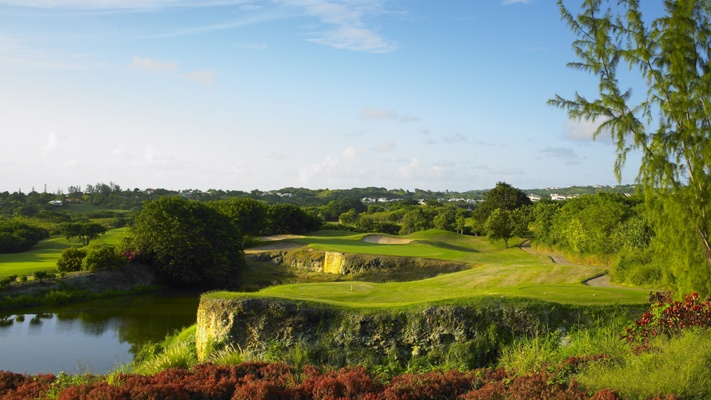
Room with a view at Royal Pavilion
Traditionally favored by British travelers seeking respite from dreary British winters, Barbados, the easternmost island in the Caribbean, has become a major player in the West Indies golf scene over the past 15 years. Cricket is the national passion, but golf fits the profile of this 21-mile-long island ringed by glorious beaches quite nicely.
Several luxury resorts are strung along the west coast of Barbados, which fronts the tranquil Caribbean Sea. Among the finest and most venerable of these oceanfront properties is The Fairmont Royal Pavilion in the parish of St. James. The hotel will reopen in November, 2010 following an extensive renovation.
It’s not the first makeover for this landmark property, which dates to the 1940’s and was the first hotel built on the island’s west coast. Formerly known as The Miramar Hotel, the original structure contained only 12 rooms and was built adjacent to the winter estate of Sir Edward Cunard, scion of the Cunard family, owners and operators of the renowned steamship company.
In 1987, Lynne and Mike Pemberton, the ‘power couple’ from UK society, redeveloped The Miramar and renamed it the Royal Pavilion. Following its acquisition by Fairmont Hotels and Resorts in 1999, the property was renamed The Fairmont Royal Pavilion.
While it now has 72 guest rooms, the resort resembles a traditional Barbadian plantation home embraced by lush tropical gardens. The public spaces and accommodations are oriented directly to the beach and the sea.
This understated, colonial-style resort will debut a new category of room this season—24 spacious, 750-square-foot beachfront junior suites with private terraces that are perfect for moonlight dining overlooking the ocean.
While even avid golfers have been known to confine themselves to a chaise lounge nestled into the warm golden sand at the edge of the calm sea, the concierge can reserve tee times for hotel guests at nearby Royal Westmoreland, a semi-private club tucked within a 500-acre resort community.
Back when golf developments were cropping up throughout the tropics in the 1990’s, Robert Trent Jones, Jr., the mover and shaker behind many of the Caribbean’s big-budget designs, conjured a beguiling layout on a former sugarcane plantation and limestone quarry nearly 300 feet above sea level. Jones, who claims he “spent $14 million and spent it well” at Royal Westmoreland, used the site as a canvas on which to meld golf architecture with landscape art. Completed in 1995, this is the course that paved the way for island’s future golf resorts and communities.
The front nine of the sturdy 7,045-yard, par-72 layout is marked by decorative grasses, artful bunkering and holes laid into coral rock canyons. Feathery ornamental grasses bordering the fairways emulate the rippled movement of the sea when the tradewinds blow. The strategically-placed bunkers, many of them modified cloverleafs, mimic the shape and color of the cumulous clouds that dot the blue sky, providing another aesthetic reference. When wooden schooners heel over in the aquamarine sea far below the fairways, there isn’t a prettier vista from a golf course anywhere in the West Indies.
A Bajan sense of place is introduced at the par-three third, where bands of chattering green monkeys often gather at a large pedestal rock beside the putting surface. The game, by the way, is won or lost on the greens, which are very slick and can be difficult to read.
The most memorable hole on the front nine is the sixth, a short par four with a large, undulating green set in the heart of the quarry, its amber-colored walls rising 40 feet above the putting surface. Ever since a hermit was discovered living in an abandoned cement mixer on the green site during course construction, the sixth has been known as the “Hermit Hole.”

Royal Westmoreland was carved from coral
Royal Westmoreland’s back nine turns the tables on players seduced by the winsome beauty and moderate challenges of the outgoing nine. The coral bedrock on this upcountry property was dynamited to make way for holes framed or bisected by deep, densely vegetated ravines. Many of the bunkers are of the “saving” variety, designed by Jones to spare players a fate worse than sand. (The jungle-like growth off the fairways is easier to attack with a machete than a five iron). The harmonious interrelationships between golf and nature, where they exist, take a back seat to rough-and-tumble holes stretched across a sloping ridge that call for forced carries over lush gullies and an ability to hit solid shots that cheat the wind. Unerring accuracy and enough horse sense to decipher optical illusions are required to score.
Respite comes at the downhill, downwind par-four 18th, where players drive to a tumbling fairway flanked by a deep ravine. The approach is played to a green backdropped by the billowy white roof of a clubhouse designed to resemble a large schooner under full sail. Inside, players can opt for blackened flying fish and other Bajan specialties served under ceiling fans. It’s the perfect place to sip a cool Banks beer (or an iced tea sweetened with liquid sugarcane) while assigning a memorability score to each hole.
If you want to peg your trip to a special event, the first annual Barbados Food & Wine and Rum Festival is expected to be the culinary event of the season. The four-day epicurean extravaganza, slated for Nov. 19 – 22, is being hosted by the island of Barbados in partnership with American Express Publishing’s Travel + Leisure, FOOD & WINE, Departures and Executive Travel magazines. For a full schedule of events and information on purchasing tickets for the festival, visit www.foodwinerum.com or www.visitbarbados.org.
Travelers seeking to book accommodations and ticket packages for this year’s festival can take advantage of special deals through American Express Vacations. Exclusive hotel rates (The Fairmont Royal Pavilion is participating) include a $1oo booking credit for reservations made by Nov. 18, 2010 for travel during the festival dates. Details: www.americanexpressvacations.com/barbados.
Contacts:
The Fairmont Royal Pavilion: www.fairmont.com/RoyalPavilion
Royal Westmoreland: www.royalwestmoreland.com
